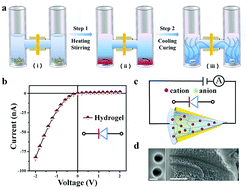Bioinspired hydrogel-based nanofluidic ionic diodes: nano-confined network tuning and ion transport regulation†
Abstract
Biological ion channel-based mass transport and signal transduction play a crucial role in physiological activities, and biomimetic nanochannels in aqueous solutions for ion transport regulation have been extensively studied. Few studies on non-aqueous systems, gel-based nanochannels, mainly focus on the charged gel network or embedded electrolytes. However, the basic issue of how a nanoscale gel network affects the ion transport in nanochannels has been neglected. Here, we demonstrate a non-aqueous biomimetic nanochannel system by employing the agarose hydrogel in conical nanochannels. To tune the hydrogel network by adjusting the gel concentration, the ion transport behavior in gel-based nanochannels is systemically investigated. The experimental results show that the ion transport behaviors in gel-nanochannels with 2% gel present similar ion selectivity and rectification performance to the aqueous system, indicating fast investigation of gel-based systems with the knowledge of the extensively studied aqueous systems. Furthermore, a gel-based solid-state diode and logic circuits were fabricated.



 Please wait while we load your content...
Please wait while we load your content...